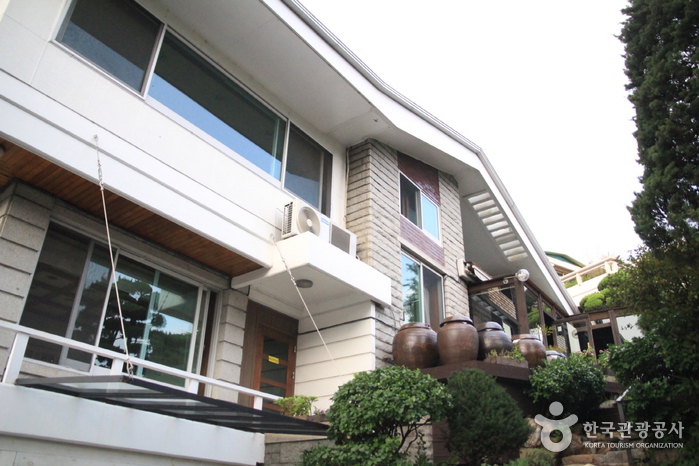Artage - Gangnam Branch [Tax Refund Shop] (아티지 강남)
5.0Km 2024-04-18
7, Eonju-ro 168-gil, Gangnam-gu, Seoul
-
Jaha Sonmandu (자하손만두)
5.0Km 2024-03-06
12 Baekseokdong-gil, Jongno-gu, Seoul
+82-2-379-2648
Jaha Sonmandu is a mandu specialty restaurant located in Buam-dong. Their signature dish is mandu guk (mandu soup), which features dumplings filled with beef, pork, mung beans, and bean curd, boiled in a clear broth. The chewy mandu skin and the clean-tasting broth, flavored with homemade soy sauce, are highlights of the dish. Housed in a renovated residential building, the restaurant offers a refined yet homey atmosphere for dining. Through the windows, diners can enjoy a refreshing view of Inwangsan Mountain.
Global Plastic Surgery (글로벌성형외과의원)
5.0Km 2025-07-29
8F, 846 Eonju-ro, Gangnam-gu, Seoul
Since its opening in 1990, Global Plastic Surgery aims to continue its operation based on its zero-accident tradition and expertise. It has become a major Korean medical brand consisting of specialists in each field. As a hospital that leads medical hallyu and sets an example to other clinics, Global Plastic Surgery is committed to research with a sense of duty and responsibility.
Global Plastic Surgery operates Aesthetic Surgery Center with 30 years of clinical experience; the Global Stem Cell Research Center dedicated to rejuvenation from the cellular level; and the Global Anti-aging Center. The clinic is exerting its best efforts as a life-long beauty clinic customized for the customer's lifestyle.
In return for the love and trust given to them, all members of Global Plastic Surgery treat customers like family and exert their best efforts to provide top-quality services to each customer through cutting-edge medical technology.
Himart - Apgujeong Branch [Tax Refund Shop] (하이마트 압구정점)
5.0Km 2024-04-18
173, Dosan-daero, Gangnam-gu, Seoul
-
Buam-dong (부암동)
5.0Km 2024-03-15
Buam-dong, Jongno-gu, Seoul
+82-2-2148-1807
Buam-dong is a village located north of Gyeongbokgung Palace. It is designated as a development-restricted zone due to its proximity to the Cheong Wa Dae, preserving the old neighborhood's appearance. There are numerous bakeries, cafés, restaurants, and small galleries housed in renovated traditional houses, making it a delightful place for a leisurely stroll. The nearby hiking trails connected to Bugaksan Mountain offer a tranquil journey through the forest, ideal for those seeking a peaceful retreat.
CU - Changjeon Forest Road Branch [Tax Refund Shop] (cu창전숲길점)
5.0Km 2024-06-27
25, Wausan-ro 32-gil, Mapo-gu, Seoul
-
Eyefit Plastic Surgery [Tax Refund Shop] (아이핏성형외과)
5.0Km 2024-06-26
596, Gangnam-daero, Gangnam-gu, Seoul
-
Onul Plastic Surgery Clinic (오늘성형외과의원)
5.0Km 2025-07-29
(10th-11th Floors, Geukdong Building), 596 Gangnam-daero, Seocho-gu, Seoul
ONUL Plastic Surgery Clinic is dedicated to prioritizing customer satisfaction with a steadfast commitment to our motto of "healthy beauty". We uphold the essential principles of plastic surgery, ensuring that every procedure adheres to the highest standards. Specializing in contouring, lifting, anti-aging, and reconstructive plastic surgery, our team of expert medical professionals provides personalized and responsible care, with the attending physician overseeing the entire process from consultation through post-surgical care. As a pioneer in the cosmetic surgery industry, we have implemented a surgical liability guarantee system since 2014. This system reflects our confidence, advanced technology, and customer-focused philosophy, ensuring we take full responsibility for our patients' outcomes. At ONUL Plastic Surgery Clinic, your well-being and satisfaction are our top priorities.
Olive Young - Sinsa Seocho Branch [Tax Refund Shop] (올리브영 신사서초점)
5.0Km 2024-06-26
1F, #106~#108, 589, Gangnam-daero, Seocho-gu, Seoul
-
Soonplus Plastic Surgery · Dermatology (순플러스성형외과의원)
5.0Km 2025-07-29
(12th-13th Floors, Mulberry Hills Medical Building), 589 Gangnam-daero, Seocho-gu, Seoul
At Soonplus Plastic Surgery · Dermatology, we are dedicated to enhancing the unique beauty of each individual through meticulous diagnoses and ongoing research.
For 25 years, we have quietly pursued the path of true beauty, and now, we are reaffirming our commitment to the principles that have guided us since the beginning.
Our focus is on natural beauty, helping you discover and embrace your own distinctive charm—one that is authentic and not influenced by fleeting trends.
This unwavering dedication to preserving individuality has been our hallmark for over two decades.
At Soonplus Plastic Surgery · Dermatology, we are committed to continuing this journey with you, bringing out the pure beauty that is uniquely yours.
![Artage - Gangnam Branch [Tax Refund Shop] (아티지 강남)](http://tong.visitkorea.or.kr/cms/resource/23/2879523_image2_1.jpg)


![Himart - Apgujeong Branch [Tax Refund Shop] (하이마트 압구정점)](http://tong.visitkorea.or.kr/cms/resource/55/2879755_image2_1.jpg)
![Eyefit Plastic Surgery [Tax Refund Shop] (아이핏성형외과)](http://tong.visitkorea.or.kr/cms/resource/03/3313403_image2_1.jpg)
 English
English
 한국어
한국어 日本語
日本語 中文(简体)
中文(简体) Deutsch
Deutsch Français
Français Español
Español Русский
Русский